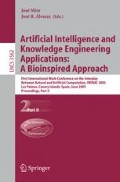Abstract
A novel immunotronic approach to fault detection in hardware based on symbiotic evolution is proposed in this paper. In the immunotronic system, the generation of tolerance conditions corresponds to the generation of antibodies in the biological immune system. In this paper, the principle of antibody diversity, one of the most important concepts in the biological immune system, is employed and it is realized through symbiotic evolution. Symbiotic evolution imitates the generation of antibodies in the biological immune system more than the standard genetic algorithm(SGA) does. It is demonstrated that the suggested method outperforms the previous immunotronic methods with less running time. The suggested method is applied to fault detection in a decade counter (typical example of finite state machines) and MCNC finite state machines and its effectiveness is demonstrated by the computer simulation.
Access this chapter
Tax calculation will be finalised at checkout
Purchases are for personal use only
Preview
Unable to display preview. Download preview PDF.
References
Forrest, S., Javornik, B., Smith, R.E., Perelson, A.S.: Using Genetic Algorithms to Explore Pattern Recognition in the Immune System. Evolutionary Computation 1(3), 191–211 (1993)
Dasgupta, D., Forrest, S.: An anomaly detection algorithm inspired by the immune system. In: Dasgupta, D. (ed.) Artificial Immune System and Their Applications, pp. 262–277. Springer, Berlin (1998)
Timmis, J., Neal, M., Hunt, J.: Data analysis using artificial immune systems, cluster analysis and Kohonen networks: some comparisons. In: Proc. of IEEE SMC 1999 Conference, vol. 3(12-15), pp. 922–927 (1999)
Xiao, R., Wang, L., Liu, Y.: A framework of AIS based pattern classification and matching for engineering creative design. In: Proc. of International Conference on Machine Learning and Cybernetics, vol. 3(4-5), pp. 1554–1558 (November 2002)
Bradley, D.W., Tyrrell, A.M.: Immunotronics-Novel Finite-State-Machine Architectures With Built-In Self-Test Using Self-Nonself Differentiation. IEEE Trans. on Evolutionary Computation 6(3), 227–238 (2002)
Chen, Y., Chen, T.: Implementing fault-tolerance via modular redundancy with comparison. IEEE Trans. on Reliability, Volume: 39 Issue 39(2), 217–225 (1990)
Dutt, S., Mahapatra, N.R.: Node-covering, error-correcting codes and multiprocessors with very high average fault tolerance. IEEE Trans. Comput. 46, 997–1914 (1997)
Lala, P.K.: Digital Circuit Testing and Testablilty. Academic, New York (1997)
Forrest, S., Allen, L., Perelson, A.S., Cherukuri, R.: Self-Nonself Discrimination In A Computer. In: Proc. of IEEE Symposium on Research in Security and Privacy, pp. 202–212 (1994)
Lee, S., Kim, E., Park, M.: A Biologically Inspired New Hardware Fault Detection: immunotronic and Genetic Algorithm-Based Approach. International Journal of Fuzzy Logic and Intelligent Systems 4(1), 7–11 (2004)
Goldsby, R.A., Kindt, T.J., Osborne, B.A.: Kuby Immunology, 4th edn. W.H Freeman and Company, New York (2000)
Juang, C., Lin, J., Lin, C.: Genetic Reinforcement Learning through Symbiotic Evolution for Fuzzy Controller Design. IEEE Trans. on Systems, Man And Cybernetics-Part B Cybernetics 30(2) (April 2000)
Moriarty, D.E., Miikkulanien, R.: Efficient reinforcement learning through symbiotic evolution. Mach. Learn 22, 11–32 (1996)
Smith, R.E., Forrest, S., Perelson, A.S.: Searching for diverse, cooperative populations with genetic algorithms. Evol. Comput. 1(2), 127–149 (1993)
Yang, S.: Logic Synthesis and Optimization Benchmarks User Guide Version 3.0, Technical Report, Microelectronics Center of North Carolina (1991)
Author information
Authors and Affiliations
Editor information
Editors and Affiliations
Rights and permissions
Copyright information
© 2005 Springer-Verlag Berlin Heidelberg
About this paper
Cite this paper
Lee, S., Kim, E., Song, E., Park, a.M. (2005). A New Immunotronic Approach to Hardware Fault Detection Using Symbiotic Evolution. In: Mira, J., Álvarez, J.R. (eds) Artificial Intelligence and Knowledge Engineering Applications: A Bioinspired Approach. IWINAC 2005. Lecture Notes in Computer Science, vol 3562. Springer, Berlin, Heidelberg. https://doi.org/10.1007/11499305_14
Download citation
DOI: https://doi.org/10.1007/11499305_14
Publisher Name: Springer, Berlin, Heidelberg
Print ISBN: 978-3-540-26319-7
Online ISBN: 978-3-540-31673-2
eBook Packages: Computer ScienceComputer Science (R0)

